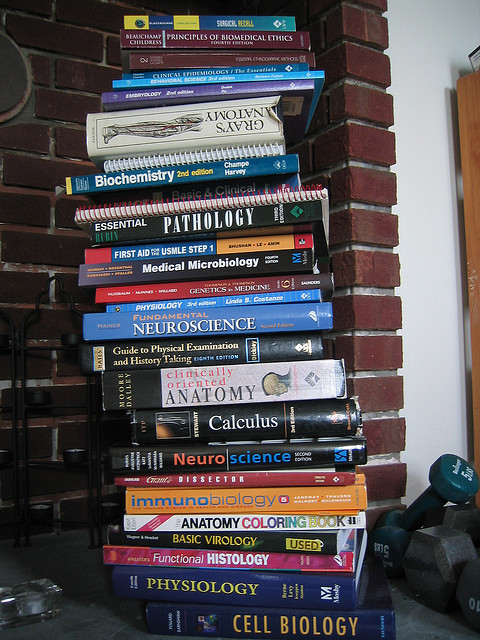 A recent survey by the National Surveys on Energy and the Environment found that only 16% Americans believe there is no solid evidence for global warming. Though good news for the public at large, there are still questions about how global warming is being addressed with students, the next generation of science-savvy citizens, particularly in the classroom and with the texts used there.
A recent survey by the National Surveys on Energy and the Environment found that only 16% Americans believe there is no solid evidence for global warming. Though good news for the public at large, there are still questions about how global warming is being addressed with students, the next generation of science-savvy citizens, particularly in the classroom and with the texts used there.
Though there have been studies on what students know about climate change, my colleague Diego Román and I wondered how science textbooks were presenting the topic. Are the textbooks presenting climate change as real and certain, matching the scientific consensus? Or are the textbooks presenting climate change as controversial, matching historic (if not current) public opinion? To answer this question, we closely examined four California middle school textbooks.
You may first be wondering, why California textbooks? California is important in the nation’s textbook market. Textbooks are often adopted at the state level; local school districts can then choose among the adopted textbooks. Since California is one of the most populous states, publishing companies create versions of textbooks specifically for California. Other smaller states, for which the publishing company can’t create a version, then pick from texts that have been created for California. In other words, the textbooks we were reviewing are important for the nation.
So how did these textbooks address climate change? What we found was not encouraging, to say the least. The textbooks used language that expressed uncertainty—uncertainty both about whether climate change was happening at all and about whether humans were responsible. Here is an example from one textbook:
Not all scientists agree about the causes of global warming. Some scientists think that the 0.7 Celsius degree rise in global temperatures over the past 120 years may be due in part to natural variations in climate. (Prentice Hall 2008, 377)
What is the problem with this section of text? First, it uses phrases such as “not all scientists” and “some scientists,” which are, at the very best, unclear. How many is not all or some? 75%? 10%? While the phrasing is technically true, “not all” in this case is only 3% of scientists. The use of these quantifiers creates doubt and uncertainty. Here is an example from another textbook:
Some scientists believe that human activities can affect the climate of our planet. (Glencoe-McGraw-Hill 2007, 399)
In addition to referring to “some scientists,” this text also says that scientists “believe” something. While it is true that scientists do believe things, in this case it might be more accurate to say that scientists have gathered data and drawn conclusions. The reference to ‘belief’ in these texts indicates uncertainty. Another common feature of the texts was the use of verbs such as “can affect” or “may be due to.” By including the modifying verb (“can” and “may”), the texts express doubt and uncertainty.
So how common is this uncertain language? Can you find it when the texts are talking about other areas of science? What about when they are addressing climate more generally? We found that the uncertain language highlighted above is not common in most science textbooks, where the text takes on an authoritative stance. Here is an example of what you more typically see:
In general, climates of locations near the equator are warmer than climates far from the equator. The main reason is that the sun’s rays hit Earth’s surface most directly at the equator. (Prentice Hall 2008, 347)
Here the text does not include the word “scientists” or refer to their beliefs. It does not use uncertain quantifiers or modifying verbs. The text about climate change was different than typical science textbook language and expressing high levels of uncertainty. In conclusion, the textbooks mirrored historic public opinion of denial rather than the scientific consensus.
So how might a middle-school student engage with the texts about climate change? Will they come to think that climate change is controversial even amongst scientists? Will they, too, deny humans are causing climate change? We didn’t explore the effects of these textbooks, but it is cause for concern. Especially since these youth are the very ones that will bear the brunt of climate change effects in the future, as well the ones who will make the decisions about what we do about it. With so much uncertainty in what they are reading in school, how can we ask them to know the science and make thoughtful decisions in the future?
You can see our article in the most recent issue of Environmental Education Research.
K. C. Busch is a Ph.D. candidate in science education at Stanford University and is currently researching how teachers and students communicate about climate change in the classroom. She earned an M.A. in science education from the University of Texas in Austin and a B.S. in ecology from Iowa State University. She has twelve years of formal science teaching experience in secondary schools in Austin, Texas, as well as two years of informal environmental education experience in Africa with the Peace Corps and in Nevada with the National Park Service. Her research is generously supported by the Neukermans Family Stanford Interdisciplinary Graduate Fellowship.
Image by Logan Ingalls via Flickr.
